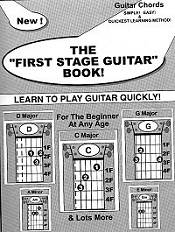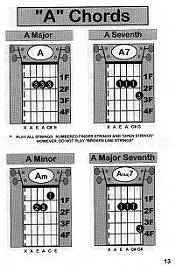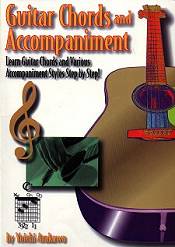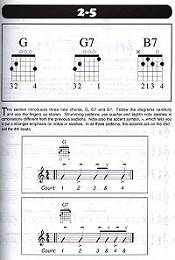Guitar Lessons: Learning From Books
The "First Stage" Guitar Book! (Christopher Winkle Products)
Guitar Chords and Accompaniment (Six String Music Publishing)
By: Alex Steininger

It seems instructional videos, books, and pamphlets are a dime a dozen these days. Each product -- regardless of its use -- makes bold promises that often fall short or don't even come close to the actual results. And, when you're talking about teaching yourself to play the guitar from books, there are shelves on top of shelves full of books that will 'help you succeed' at your goal. But, do any of them really work? I've tried many of them, sometimes for fun, sometimes to be serious, and often just to see if the claims these books make are sufficient to the end results. Luckily, I've found two books that excel at what they do, and even though you may struggle through them, if you work hard at it, and put in the amount of time each requests (an hour a day of practice on what you've learned) then the end results may just be what you're looking for. The first book we'll be looking at is Clisthenes F. Lopez, Jr.'s THE "FIRST STAGE" GUITAR BOOK! It claims to be a "simple method which will help you to learn guitar chords much sooner than previous methods, so that you can enjoy playing your favorite guitar tunes as soon as possible." The first thing it teaches you is the basics: tuning the guitar strings, how to hold a guitar pick, positioning the body of the guitar, positioning your left hand on the guitar neck, positioning fingers on guitar neck, and how to strum the guitar strings. From there, it gives you an illustration of the guitar neck, the notes, and where the notes are located; all of this in an easy-to-follow illustration. From there, you begin learning about the chords, starting with the "C" chord and all of its related notes (C major, C seventh, C Minor, C Major Seventh).
The first book we'll be looking at is Clisthenes F. Lopez, Jr.'s THE "FIRST STAGE" GUITAR BOOK! It claims to be a "simple method which will help you to learn guitar chords much sooner than previous methods, so that you can enjoy playing your favorite guitar tunes as soon as possible." The first thing it teaches you is the basics: tuning the guitar strings, how to hold a guitar pick, positioning the body of the guitar, positioning your left hand on the guitar neck, positioning fingers on guitar neck, and how to strum the guitar strings. From there, it gives you an illustration of the guitar neck, the notes, and where the notes are located; all of this in an easy-to-follow illustration. From there, you begin learning about the chords, starting with the "C" chord and all of its related notes (C major, C seventh, C Minor, C Major Seventh).
 This teaching method continues throughout, with a new chord appearing on each page. Helpful tips along the way help you better put to use the knowledge you're acquiring throughout the pages, so as the notes get harder, you're prepared with quick and easy tips and tricks to fully utilize what you're learning.
This teaching method continues throughout, with a new chord appearing on each page. Helpful tips along the way help you better put to use the knowledge you're acquiring throughout the pages, so as the notes get harder, you're prepared with quick and easy tips and tricks to fully utilize what you're learning.
Each chord (with four variations of that chord on one page) is graphically illustrated so you can not only comprehend what you're learning, but also so you can check and make sure your fingers are in the right position. Also, it makes for a useful tool to flip back and check out if you've forgotten the correct position for a chord.
 The other book, GUITAR CHORDS AND ACCOMPANIMENT, is a bit more professional in appearance. It is in full color, book format (as opposed to "FIRST STAGE"'s spiral binding), and a lot thicker too. Thicker doesn't always mean better, though, and some of the best products on the market are independently released, so more "professional" doesn't say much either. But, in this case, GUITAR CHORDS AND ACCOMOPANIMENT takes everything several steps further, and presents it in an even clearer, more organized fashion.
The other book, GUITAR CHORDS AND ACCOMPANIMENT, is a bit more professional in appearance. It is in full color, book format (as opposed to "FIRST STAGE"'s spiral binding), and a lot thicker too. Thicker doesn't always mean better, though, and some of the best products on the market are independently released, so more "professional" doesn't say much either. But, in this case, GUITAR CHORDS AND ACCOMOPANIMENT takes everything several steps further, and presents it in an even clearer, more organized fashion.
Instead of giving you a brief text summary of how to hold the guitar, GUITAR CHORDS AND ACCOMPANIMENT offers live shots on the proper way to hold the guitar; it pinpoints every little piece of the guitar, from the head to the bridge, and gives you detailed instructions on how to tune your guitar (whereas "FIRST STAGE" tells you to just buy a guitar tuner). Another advantage GUITAR CHORDS offers is lessons on basic music notation, time signatures, pitches and clef, as well as how to use guitar extras like a capo.
 The lessons are even broken down to simpler, easier to learn blocks consisting of two or three notes at a time, as opposed to four. Each lesson also ends with some practice music, which I found to come in very handy. As the lessons develop, so does your guitar playing chops. You start out learning E minor seven and E minor, putting to use what you've learned in the practice sessions, and with each new notes you learn, the old and new are incorporated so you can learn how to switch from one to the other. And, like I said, as you develop, so do lessons. They get harder and harder, and push you further and further with each one.
The lessons are even broken down to simpler, easier to learn blocks consisting of two or three notes at a time, as opposed to four. Each lesson also ends with some practice music, which I found to come in very handy. As the lessons develop, so does your guitar playing chops. You start out learning E minor seven and E minor, putting to use what you've learned in the practice sessions, and with each new notes you learn, the old and new are incorporated so you can learn how to switch from one to the other. And, like I said, as you develop, so do lessons. They get harder and harder, and push you further and further with each one.
Where as "FIRST STAGE" teaches you the basics, GUITAR CHORDS teaches you the basics, helps you get the basics down cold, and then offers up several more lessons for those daring enough, and confident enough in their skills, to progress and learn more. Now, I would have to recommend a different book for each price range, if the prices where that different. But they're not. You can purchase FIRST STAGE for $14.50 plus shipping, while GUITAR CHORDS is a mere forty-five cents more plus shipping.
Each book is very insightful, well written, and offers up plenty for the guitar beginner to chew on and cut their teeth with. Both are extremely helpful and actually come through on all promises made. But, GUITAR CHORDS stands out as a book with a lot more to offer. And, since the cost is almost identical, I would go with it. Or, if you're really eager to learn to play guitar, go with both and decide for yourself, because no matter how good one book is for one person, it might not be the right source for another. Everybody learns differently, which needs to be taken into account, too. I'll give "FIRST STAGE" an A and GUITAR CHORDS an A+.
THE "FIRST STAGE" GUITAR BOOK! is created by Chris F. Lopez, Jr. You can visit him on the web at http://www.quickstartguitar.com or e-mail him at [email protected]. The book is $14.50 + shipping and handling.
GUITAR CHORDS AND ACCOMPANIMENT is written by Yoichi Arakawa and published by Six String Music Publishing. Visit them on the web at http://www.sixstringsmusicpub.com or e-mail them at [email protected]. The book is $14.95 + shipping and handling.

